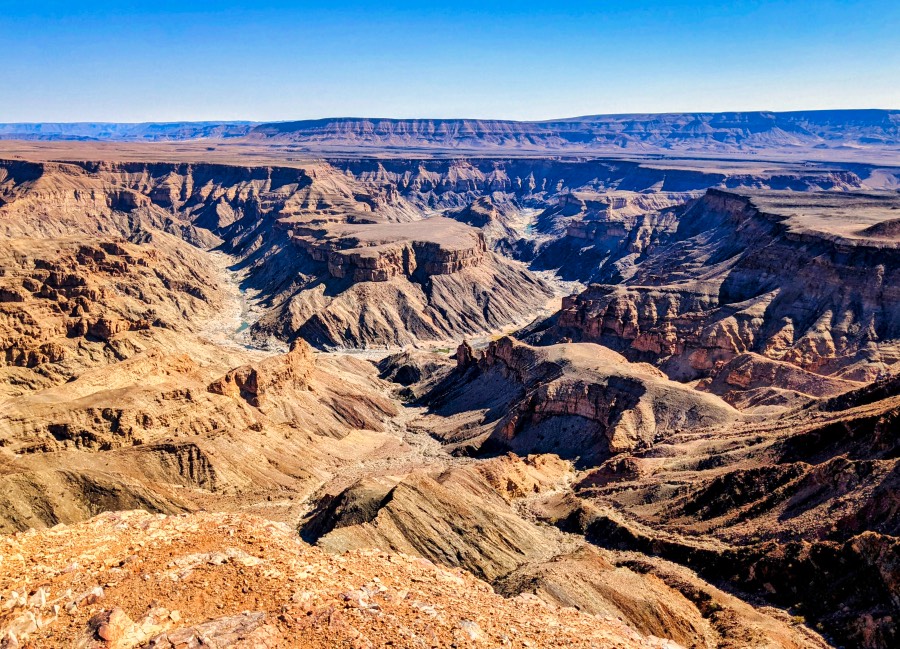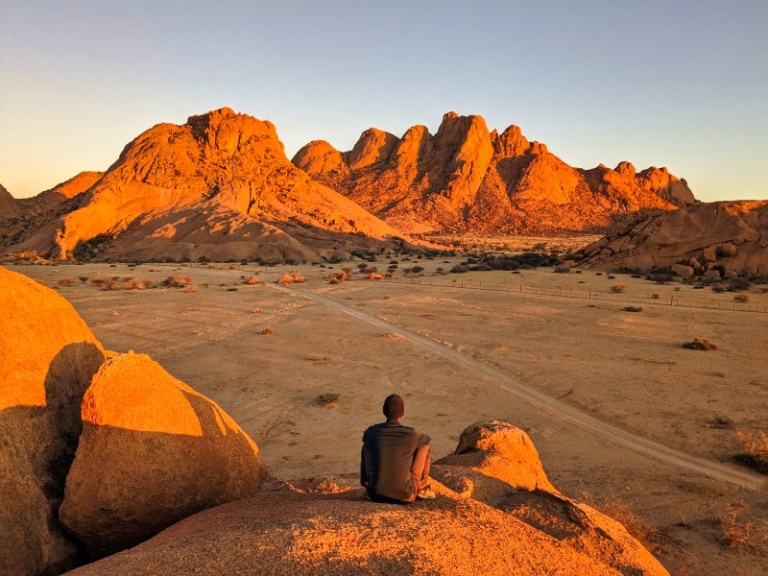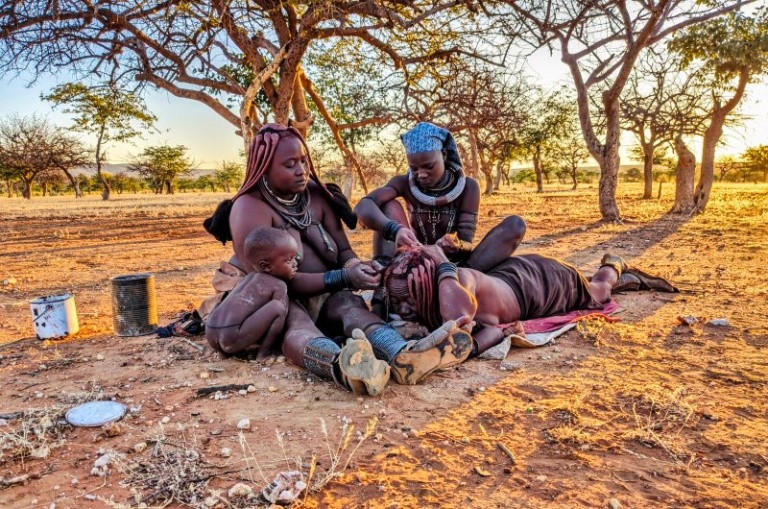The Essential Guide To Hiking Fish River Canyon (2024)
The Fish River Canyon is a magical place. And there’s no better way to experience this magic than undertaking an epic multi-day hike through it.
Walking through this ancient landscape over the course of 3 – 5 days is an incredible experience and one we recommend for all adventurers who find themselves in Southern Africa.
Want to find out more? Planning your own Fish River Canyon hike? Read on for our complete guide to hiking Fish River Canyon, containing all the information you need to get yourself organised and out on the trail.
Namibia Travel Resources
- Getting there: search for flights to Namibia
- Where to stay: find a guesthouse, hostel or hotel
- Guidebook: pick up a copy of Bradt’s Namibia
- How to get around: rent a car or 4WD
- Travel insurance: get travel insurance for your trip
- Money: get a Wise travel card to save big time in Namibia
- Gear: pick up a Steripen for clean water 24/7
Fish River Canyon Hike Overview
- Location: Ai-Ais / Richtersveld Transfrontier Park, Southern Namibia
- Length: 65 – 90 km
- Time: 3-6 days
- Season: 1 May – 15 September
- Type: One-way
- Booking Required: Yes
- Sleeping: Camping
- Start: Hobas
- Finish: Ai-Ais
- Difficulty: Moderate
- What to expect: Rock, sand, epic sunsets and sunrises, star-filled skies and some of the most dramatic canyon scenery on this planet
What is the Fish River Canyon Hike?

The Fish River Canyon hike is, well, a hike through the Fish River Canyon. Beyond the obvious, it’s a 65 – 90 km hike through the second-largest canyon in the world.
Why the difference in distance? Well, because there are a number of shortcuts along the hike which can vary the actual km’s walked. If you follow the river religiously, you’ll walk around 90 km. If you take all the shortcuts, then expect 67 km. Our advice? Take the shortcuts.
The Fish River Canyon hike is a true African bucket-list activity. It’s extremely popular with South Africans, but getting on the radar of more overseas visitors every year. But just because it’s popular doesn’t mean it’s crowded. Numbers on the Fish River Canyon hike are limited to 30 people a day, meaning it’s still a very tranquil and peaceful experience. This does mean, however, that you do need to book in advance (see below).
In a continent with very limited independent hiking opportunities, trust us, this is one you don’t want to miss.
Spending time in Namibia? Check out our list of the top 10 camping sites in Namibia
Fish River Canyon Hike Location
The Fish River Canyon is located in the Ai-Ais / Richtersveld Transfrontier Park in southern Namibia. The nearest town of any size is Keetsmanshoop, although you’d be hard-pressed to think of Keetsmanshoop as a bustling metropolis.
The Fish River Canyon hike begins at Hobas and ends in Ai-Ais, which is a little ‘resort’ at the end of the trail. We use the term resort here quite loosely, because, Ai-Ais isn’t exactly anything fancy (in fact, it’s a bit dishevelled).
Ai-Ais is approximately 800 km north of Cape Town and 750 km south of Windhoek, making it a perfect stop if you’re road-tripping Africa.
Read next: The Essential Guide to Hiking the Congo Nile Trail
Fish River Canyon Hike: Good to Know
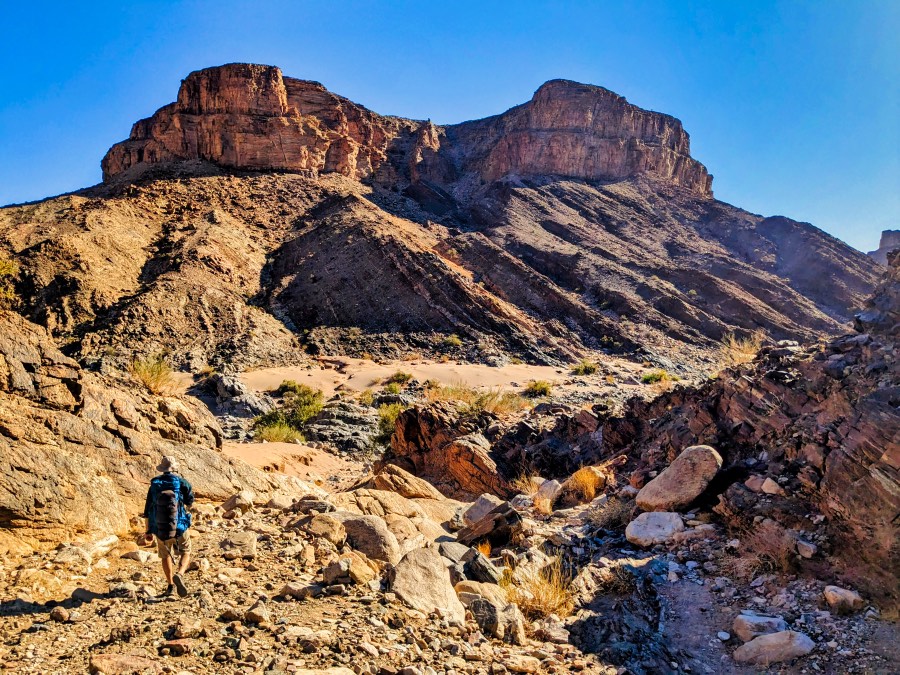
It’s important to note that the Fish River Canyon hike is different every year. The fluctuating weather and the changing levels of water in the canyon can make the Fish River Canyon hike a completely different experience from one year to the next. This is one of the things that makes it so special and why people come back multiple times to conquer it.
We did the Fish River Canyon hike last year, at the end of May 2023. This was one of the driest years ever in the Fish River Canyon and it completely shaped our experience. Had we hiked in a wetter year, it would have been a completely different hike!
Once you start the Fish River Canyon hike, you’re committed, with no easy way out. On the trail, there are two emergency exits: around the 14 km mark (which is spray-painted on the canyon wall) and another just before the Pink Palace (not as obvious).
Important: confusingly, the ‘0’ or starting point on the Slingsby map (which is THE map to use) is at the bottom of the canyon and doesn’t include the 1.7 km descent from Hiker’s Viewpoint. So, what this means is that the ’16 km’ marker on the map is almost actually 18 km of walking when you’ve factored in the descent. All references we use correspond to the map and thus start at the bottom of the canyon. Read more on navigation below.
Best Time to Do the Fish River Canyon Hike
The Fish River Canyon is only open for hiking from 1 May to 15 September. Outside of this time, it’s summer in Namibia, meaning scorching hot temperatures that will destroy even the most seasoned of hikers.
The best time to hike the Fish River Canyon is at the start of the season, in May. During this time, water levels will be their highest and there is the least amount of human interference on the trail.
We’ve heard stories about the trail getting really dirty at the end of the season, as more people walk through and fail to clean up after themselves (don’t be that person!).
Visiting the Himba in Namibia? Read our guide on How to Visit a Himba Tribe Ethically and Responsibly
How to Book the Fish River Canyon Hike
The Fish River Canyon hike must be booked in advance through Namibia Wildlife Resorts (NWR). To book, you can either call them directly (although their Cape Town number no longer works, so you must call the Namibia number) or email them.
Due to its popularity and the limited numbers allowed each day, many people (including many we met personally), book a year in advance.
If you’re like us and are allergic to planning anything more than a couple of weeks in advance, never fear, because it is possible to get last-minute spots. Every year there are inevitably cancellation spots, so if you’re flexible with dates, there’s a good chance you’ll be able to find a spot.
Your best bet is to contact NWR around a month or so before you want to start the Fish River Canyon hike to inquire about dates. Simply send an email to inquire and they should get back to you within a couple of days.
We know people who called only a week before and were told there were plenty of available spaces (but for some reason, were almost double the price).
Another way to find cancellation spots is to join the “I Hiked the Fish River Canyon” Facebook group. Cancellation spots are regularly advertised.
Fish River Canyon Hike Minimum Group Size

There is a minimum group size of 3 to do the Fish River Canyon hike. What if, like us, you’re a couple?
Well, you have a few options.
You can inquire with NWR about any groups that have cancellations and that are looking for additional numbers to join them. Because you pay for the entire group when booking, if an individual from a group cancels, the group leader will often contact NWR to advise that they’re looking for new people to join the group to fill the spot. If your dates match with a group looking for some extras, then NWR will give you the contact info for the group leader.
This is exactly what we did. We were put in touch with a lovely woman who had multiple spots to fill. We touched base and joined her group and sent her the money for the permit via Wise. It was too easy.
Alternatively, if there aren’t any groups with cancellations on your dates, but there are available spaces, you could ask NWR for the contact information for someone from a group starting that day, then contact them and ask if you could join their group.
You can also check in on the Fish River Canyon hike Facebook group (see above) about joining a group.
And finally, if none of the above work, then you could always book for three and wing it on the day. That said, NWR was somewhat pedantic with our forms when we signed in at the start of the hike, so I’m not super confident that they’d let you start as a group of two, even if your third group member ‘was sick’. If this has worked for you, please let us know in the comments below!
Read about exploring wild Kaokoland in northern Namibia
Medical Certificate

All hikers need to bring a medical certificate (supplied by NWR) that has been completed by a doctor within 40 days. This will state that you’re fit to do the Fish River Canyon hike and is surprisingly invasive, requiring even a urine test (really).
Be sure to use the one supplied by NWR directly, rather than one floating around on the web, as it has changed in recent years.
Read about hiking to Mount Stanley in the epic Rwenzori Mountains
Transportation to the Fish River Canyon
As with any destination in Namibia, public transportation to Fish River Canyon is pretty much non-existent and you really need your own car to get there.
If you don’t own a set of wheels, then we strongly recommend renting a car, as this will make your entire Namibian experience much more enjoyable.
Pro tip: use Discover Cars to find the best deals on rentals.
If you’re flying in, both Windhoek and Cape Town have international airports and are pretty comparable in distance. Cape Town is a much larger hub though and flights will almost undoubtedly be cheaper.
Our recommendation? Take a look on Skyscanner a couple of months in advance for the best prices.
Related: The Complete Guide to Visiting Spitzkoppe
How to get to the start of the Fish River Canyon Hike

If you’re driving yourself to the Fish River Canyon, then you can leave your car at either Hobas (the start of the hike) or Ai-Ais (the end of the hike).
There is a shuttle from Ai-Ais to Hobas. Normally, the departure times are 7am and 11am, but they do periodically change. You don’t need to book this in advance. It can be arranged the night before, or if taking the 11am shuttle, even the morning of.
Important: If you’re taking the shuttle from Ai-Ais to Hobas the day you would like to start, factor in 3 hours before you actually start hiking. This takes into account the travel time from Ai-Ais to Hobas, plus a LOT of time going through many indemnity forms from NWR.
How much does it cost to hike the Fish River Canyon?
The Fish River Canyon hike isn’t overly expensive, but like everything in Namibia, seems to be increasing rapidly in cost every year.
There are a few different costs involved in doing the Fish River Canyon hike: the permit and the national park fee, which are obligatory, and the shuttle from Ai-Ais to Hobas, which is optional.
- The permit for the hike is 535 NAD per person, regardless of nationality.
- The national park entrance fee varies depending on nationality.
- For Namibian citizens, it costs 50 NAD.
- For SADC citizens, it costs 100 NAD.
- For all others, it costs 150 NAD.
The shuttle from Ai-Ais to Hobas costs 400 NAD, regardless of nationality.
In addition, you’ll need to factor in the costs of getting to Fish River Canyon and your food and supplies for the duration of the hike.
How Difficult is the Fish River Canyon hike?
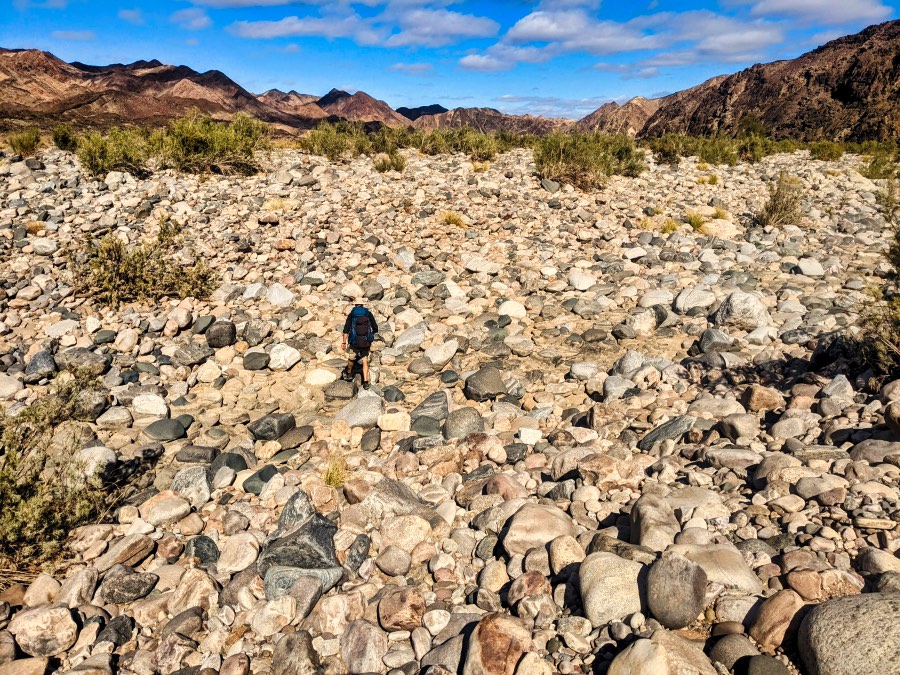
If you are an experienced hiker with a good level of fitness, then the Fish River Canyon hike will not be terribly difficult for you. The terrain is largely flat and distances each day are not overly long.
If you’re new to overnight hiking, or have just never carried a pack for long distances before, then it will be a new (and hopefully, exciting) challenge for you.
However, it’s important to note that your experience hiking the Fish River Canyon will be shaped by a number of variables, which can be completely different at any given time. The biggest of these include the weather and water levels in the canyon – both of which can significantly alter the hiking experience.
If the weather is hot (which it normally is), then it will be much more difficult. You’ll have to face long hours under the sun with no shade, which is really draining. You’ll also need to drink more water and thus carry more water (which makes your bag significantly heavier).
If you don’t have experience hiking in an arid climate, you will most likely find the dry, hot conditions an extra challenge.
The water levels in the Fish River Canyon are another important variable. If there is a lot of water in the river, then the hike can be more difficult as you have a narrower path to walk on and more river crossings.
However, if there is little to no water in the canyon (as there was last year, 2023), then water scarcity is a real issue that you’ll have to deal with.
Hiking the Fish River Canyon In 2024
For those hiking the Fish River Canyon in 2024, it’s looking like the water levels are going to be very low again – like last year. As the hiking season has yet to begin, and there’s still a chance for rain, we’ll just have to wait and see.
Last year was one of the driest on record, with very little natural water in the canyon. It was so dry that NWR deployed water marshals to provide water at a few select spots in the Fish River Canyon.
Regardless of the water situation, you MUST bring a water purification method with you and the capacity to carry 3L per person.
As a note of confidence, we drank from many water sources (even when they looked dubious) and purified it all with our Steripen and were fine. It didn’t always taste great, but we didn’t dehydrate and we didn’t get sick.
Pro tip: to improve the taste of the water, add some juice mix. It’ll greatly mask the bad taste of the green, stagnant water.
Our advice for hiking during water scarcity: drink when you can (i.e., when you’re at a water source), so that you don’t have to carry so much. Then, when hiking, the best approach is to run a bit thirsty and take sips, rather than quench your thirst. This tells your body to retain water rather than expel it.
In 2023, NWR provided water at 3 points along the trail: at Bushy Corner, the top of the pass on the Four Finger Rock shortcut and at the Pink Palace. Although it is indicated that they’ve provided water at Three Sisters, we’ve heard reports that it’s not there (and is at the top of the pass on the Four Finger Rock shortcut instead).
When the Fish River Canyon hiking season opens in 2024, we’d greatly appreciate feedback on the water situation!
Fish River Canyon: The Trail
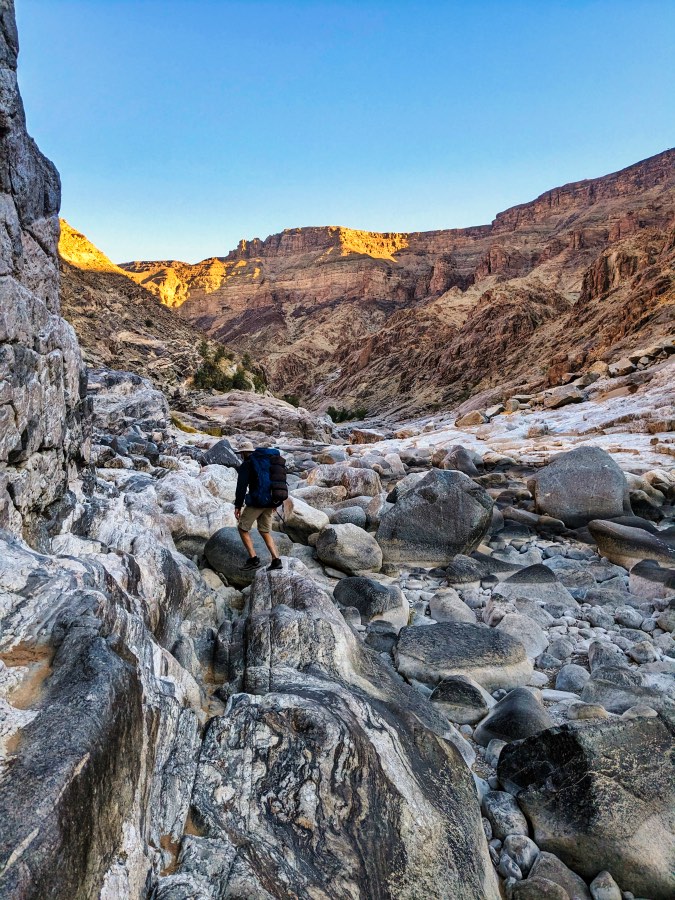
The Fish River Canyon hiking trail is a classic arid landscape trek: it’s rocky, sandy and super exposed with almost no shade whatsoever. Be prepared to be out in the open all day – so bring a good hat and sunscreen.
Interested in more arid landscape trekking? Read about the Larapinta Trail in Australia
In general, the terrain is very consistent. We kept hearing that it would ‘get easier’ or ‘get better’ after a certain benchmark, which never happened. Overall, it’s the same throughout the entire trail: a constant mix of sand, rock and path. Sometimes it’s really sandy, sometimes it’s really rocky and sometimes (but not often), you have a nice easy path to walk on.
For a large part of the Fish River Canyon hiking trail, the path follows the river. However, starting from around the 35 km mark, several shortcuts cut through big bends. These are generally on better terrain and easier to walk on.
For descriptive purposes and to help with planning, we’ve split the trail into 6 different sections.
Section 1: Hiker’s Viewpoint to the Canyon Bottom
The hike starts at Hiker’s Viewpoint. The descent from Hiker’s Viewpoint to the canyon floor is steep but manageable, losing 460m of elevation over 1.7 km lateral distance. It should take anywhere from 1 – 1.5 hours.
It sounds like a lot, and it is, but it wasn’t as bad as I was expecting. To assist, chains are provided on the more difficult sections near the top. Just take your time and watch your footing.
There are some nice pools at the canyon bottom, which is a good spot to swim and, if you start late, camp on your first day.
Section 2: Canyon Bottom to Palm Sulphur Springs
Once you hit the canyon floor and get going, it is SLOW going. Think lots of sand and lots of rock. Our average speed was around 2.5 km/hr (and we normally hike around 4 km/hr). Don’t worry too much about it, though, and just enjoy the beautiful scenery from the canyon floor.
From 0 – 5 km, there are many good sandy camping spots. At around 4.5 km is a particularly beautiful spot (and indeed, where we camped the first night).
From 5 km to ‘big pile of rocks’, there aren’t really any suitable camping spots, so if you’re after a short first day, it’s best to camp before 5 km.
Palm Sulphur Springs is a great little oasis in the Fish River Canyon. It’s a great spot to either camp or just spend a considerable amount of time during the day. Although it’s cold, you can swim in the pool. The actual springs are very hot, so be careful around them!
Also, be sure to fill up your water at Palm Sulphur Springs.
Section 3: Palm Sulphur Springs to Zebra Pools
From Palm Sulphur Springs to Zebra Pools, the trail is noticeably easier and faster going. After leaving Palm Sulphur Springs you’ll notice the canyon starting to become wider.
There are a couple of potential camping spots directly after Palm Sulphur Springs, but then nothing until around the 23.5 km spot.
At 23.5 km is a good spot to camp, which often has water. From 23.5 km to Zebra Pools are several nice flat pitches as well.
Section 4: Zebra Pools to Bushy Corner
From Zebra Pools until Bushy Corner, the trail is rocky and sandy again. We found this to be some of the most arduous hiking on the entire Fish River Canyon hiking trail.
Just past Wild Geese Pools, the trail can be somewhat confusing (because it opens up more). Around this point, there are different side canyons and options to go down. This is a good time to consult the map and take stock of where you are. Look out for big cairns which mark the way.
Wild Geese Pools has reliable water (even in 2023) and immediately after is a nice camping area. There are clearly established pitches with spots for fires.
When approaching Bushy Corner, stick to the inner right (closer to the inner canyon wall). There is a much better trail to follow than the rocky riverbed.
There are lots of nice places to camp around Bushy Corner with good shade. Bushy Corner is also a NWR waterpoint, so it has reliable, fresh water. There are two tanks: one in the inner route, very close to the pass in the canyon walls. The other is right by the shortcut, near the bend in the river.
Section 5: Bushy Corner to Bikini Beach
Section 5 is the shortcut section! There are 3 big shortcuts in this section of the Fish River Canyon hike.
The first is at Bushy Corner. It’s actually further down the trail than indicated on maps.me, pretty much near the bend in the river. Keep your eyes on the canyon wall and you’ll see the shortcut going up and over the rocks. After a quick scramble, it flattens out nicely and smoothly. This one saves you a lot of rocky walking, so we highly recommend taking it!
The next shortcut, and the first big one, is at the 50 km mark against the outer canyon wall. Keep your eyes peeled because you could miss it. First, look for the 50 km marker spray painted on a rock. The shortcut is a few metres down from that, with big arrows spray-painted to guide you.
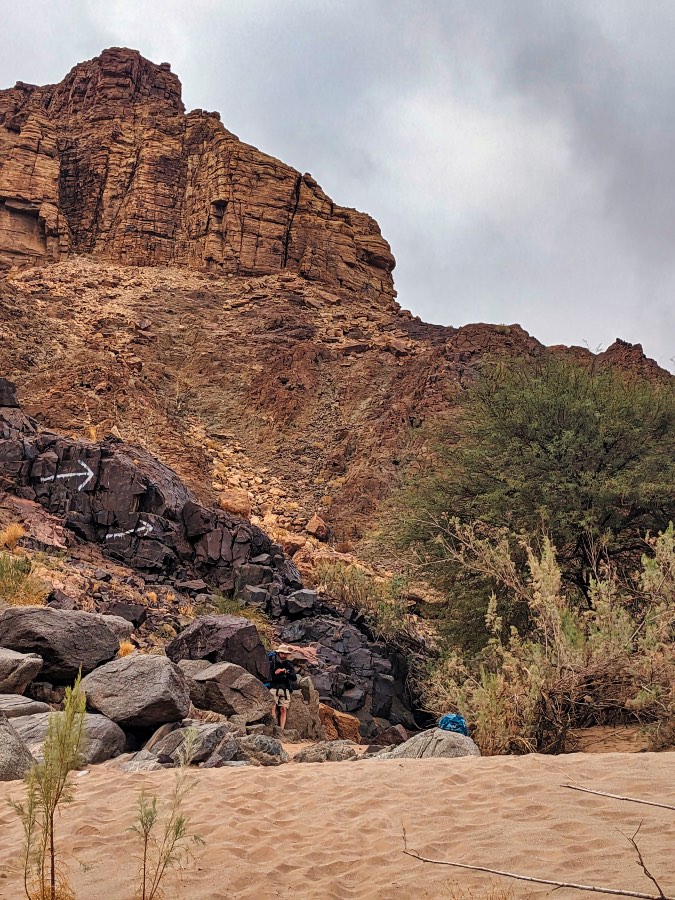
This shortcut is great. Not only does it save you a heap of time, but it’s better terrain and very beautiful. It’s a very different perspective from the riverbed – almost like being on the moon.
The next shortcut at Four Finger Rock isn’t signposted, but it’s pretty easy to spot. There’s a clear path going up the pass towards Four Finger Rock, which you can see from a distance. Also, in 2023 there is an orange water tank up there, which again, you can see from far away.
After the German soldier’s grave, the canyon completely opens up. It’s sudden and dramatic. It feels much more like walking amongst mountains than in a canyon. This is also an easy time to get lost, so another good time to consult your map.
If it’s a dry year, there is good camping in the riverbed around Fool’s Gold Corner. Bikini Beach is also an excellent place to camp.
Section 6: Bikini Beach to Ai-Ais
This is the final stretch! It’s very open and continues the same theme: rock and sand.
The last 1 km on the sand before you reach Ai-Ais is particularly torturous.
Suggested Itineraries
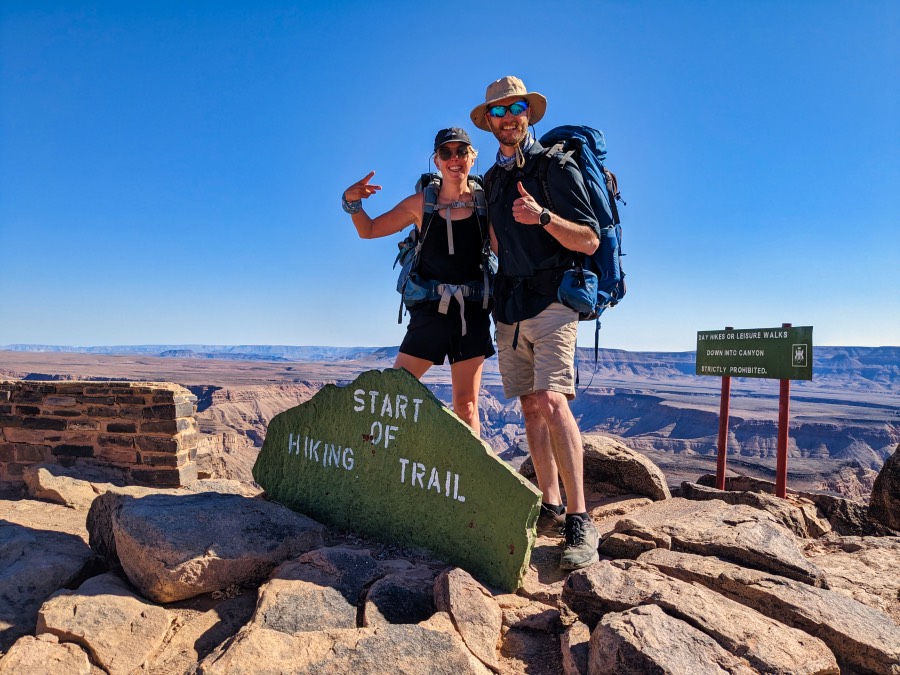
Whether you do the Fish River Canyon hike in 3, 4 or 5 days is completely up to you and depends on your experience and level of fitness. We even met people hiking in 6 days!
The itineraries we’ve provided below are simply suggestions – there are multiple variations you can choose. The choice is yours, my friend!
3-Day Fish River Canyon Hiking Itinerary
This option is only recommended if you’re really stretched for time. To complete the Fish River Canyon hike in 3 days, you’ll need to be really fit and experienced.
Day 1: Hiker’s Viewpoint to Palm Sulphur Springs
Day 2: Palm Sulphur Springs to Bushy Corner
Day 3: Bush Corner to Ai-Ais
4-Day Fish River Canyon Hiking Itinerary
If you’re fit, the Fish River Canyon can easily be hiked in 4 days. If choosing this option, it’s a good idea to start early on day 1.
Day 1: Hiker’s Viewpoint to Palm Sulphur Springs
Day 2: Palm Sulphur Springs to Wild Geese Pools
Day 3: Wild Geese Pools to Fool’s Gold Corner or Bikini Beach
Day 4: Fool’s Gold Corner or Bikini Beach to Ai-Ais
5-Day Fish River Canyon Hiking Itinerary
This is a great option if you’re a novice hiker, or just want time to relax and enjoy the spectacular Fish River Canyon scenery. We hiked the Fish River Canyon in 5 days and loved it.
With this option, you can have a late start on day 1.
Day 1: Hiker’s Viewpoint to camp around 4.5 km
Day 2: Camp around 4.5 km to Zebra Pools
Day 3: Zebra Pools to Bushy Corner
Day 4: Bushy Corner to Bikini Beach
Day 5: Bikini Beach to Ai Ais
What to Expect On the Fish River Canyon Hike
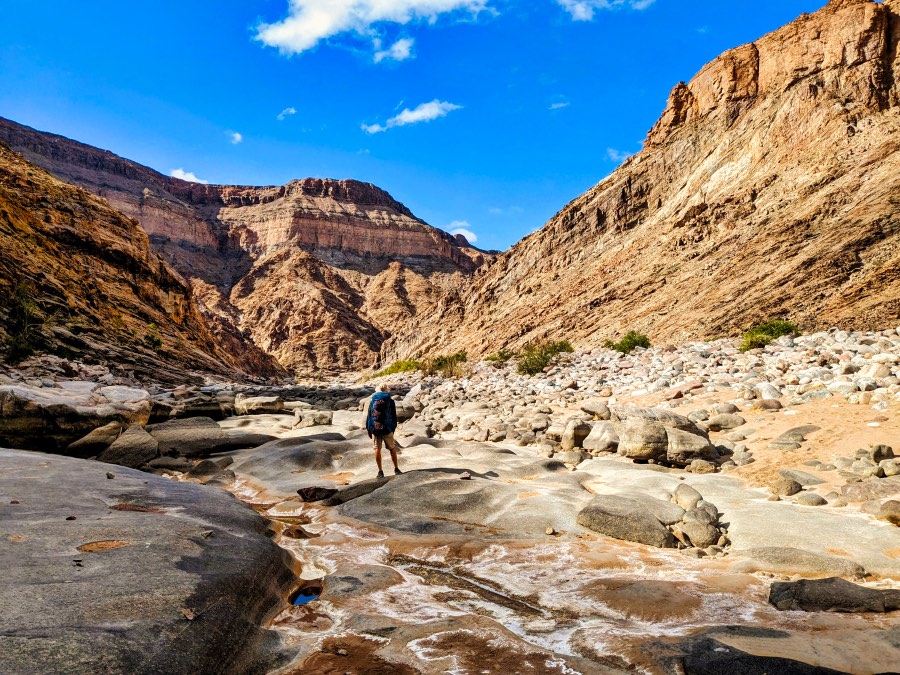
Weather
The weather in Fish River Canyon can vary, but as a general rule, it’s best to plan and prepare for hot days and cold nights. We were lucky and got mild weather, but I consider that an exception rather than the norm.
Average daytime temperatures during the hiking season are around 25 – 27C and can drop to as low as 2C at night. We always use this website for weather in more obscure locations such as Fish River Canyon
Curious about how to prepare? If you’re using a tent, bring a sleeping bag rated to at least 0C. If you’re going without, then bring one rated to at least -5C. A good sleeping pad is also essential – not just for comfort, but the insulation from the ground will keep you much warmer.
Camping
Sleeping in the canyon is beautiful and a great experience during the Fish River Canyon hike.
There are no official campgrounds in the Fish River Canyon. Instead, just find a nice flat, sandy spot, ideally close to a water source and make your home for the night.
Some people use a tent and others choose to sleep out in the open under the stars – this is simply a matter of personal preference. If sleeping out in the open, be prepared with cold-weather gear as nights can get pretty cold (you’ll want a sleeping bag rated to at least -5C).
Food
You need to bring all your own food for the duration of the Fish River Canyon hike. Think light and easy to prepare.
For dinners, our favourite options are instant noodles, hardboiled eggs (they’ll last for up to 3 days) and quick-cooking pasta packages. Dried fruit, nuts and granola bars are great for snacks.
For breakfast, we make our own instant oatmeal mix with lots of dried fruit, chia seeds and nuts inside, served alongside instant coffee and powdered milk.
If you’re after hiking meals, we love Mama Alles. The meals are delicious, affordable, filling and nutritious! (Our personal favourite is the Moroccan Tagine). They’re cheapest at Camp and Climb, but can also be found at Outdoor Warehouse.
Navigation
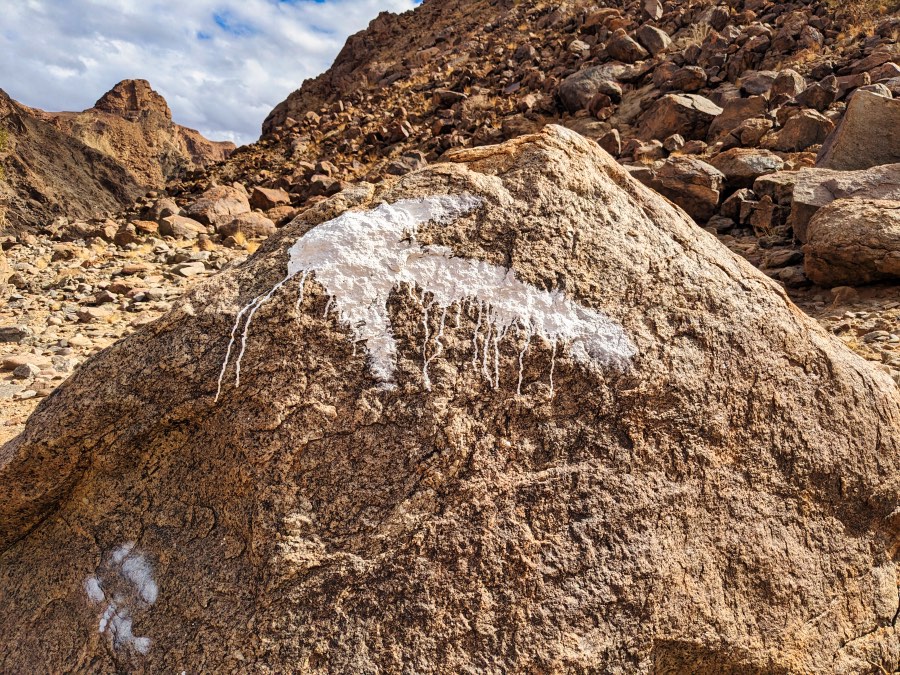
The Fish River Canyon is relatively easy to navigate. The first 3 sections are really straightforward, but after that, the canyon opens up more and it becomes more challenging to find your way.
The Slingsby Fish River Canyon map is highly recommended. While there is a digital map of the trail on maps.me (which you should also have), the Slingsby map has all the other information you need, including the names of important landmarks, water sources and good camp spots. It’s very, very useful.
If you don’t want to fork out the 300 ZAR/NAD or so for the map, or are just disorganised and forgot to buy it in advance, it’s on the wall in the NWR office in Ai-Ais and you can take pictures of it for reference (which is what we did).
Rubbish
Pack it out! You must pack out all your own rubbish while hiking the Fish River Canyon. Carry a few small bags (double bag it just in case of leaks) and carry it with you.
The Deuce Ultralight Trowel is a great hiking tool that allows you to Leave No Trace cleanly.
Pro tip: to minimise rubbish on the trail, decant as much as your food beforehand as possible.
Safety
Hiking the Fish River Canyon is an exercise in isolation. We highly recommend walking with a personal locator beacon (PLB) or similar device in case of any emergencies.
The biggest concerns in this environment are heat stroke and dehydration. Be sure to have a good hat, rest in the shade and drink plenty of water.
As with all hikes, you should always carry a first-aid kit (complete with a snakebit bandage) and be mindful of snakes and scorpions. Be sure to shake your boots out in the morning before putting them on!
Unfortunately, accidents do happen, so good travel insurance is essential. We use and recommend SafetyWing, as they have great coverage for hiking.
Mobile Reception and Electronics
There is no reception in the Fish River Canyon, so make sure to download any offline maps you may need.
We also recommend bringing a power bank to keep your devices fully juiced.
Fish River Canyon Hike Tips and tricks
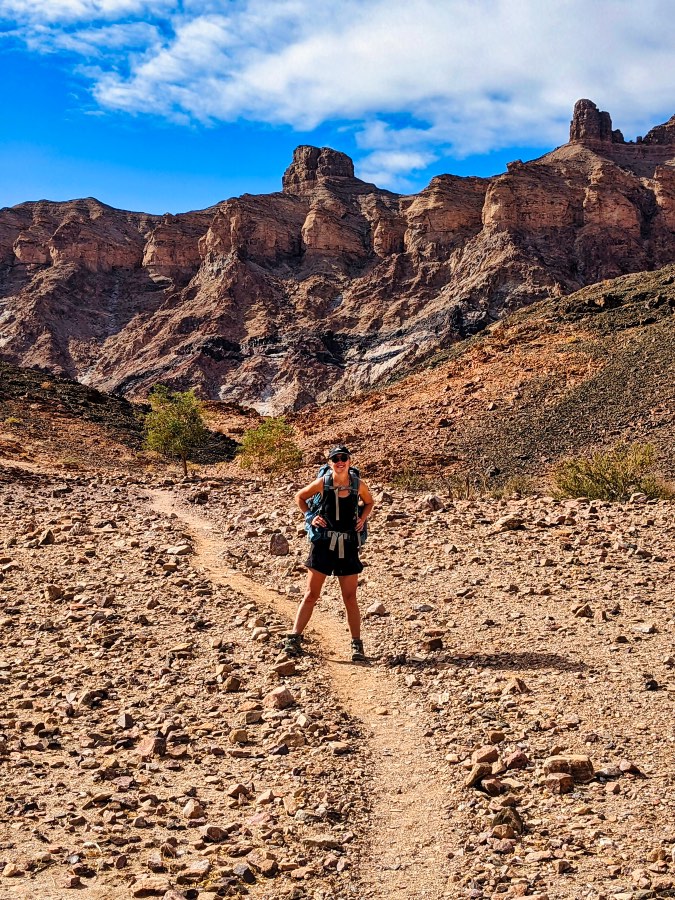
- Make sure to stop at the regular viewpoint en route to Hiker’s Viewpoint. It offers a great perspective of the Fish River Canyon and very different to that from the canyon floor.
- When hiking, follow the footsteps in the sand. This is usually a sign you’re on the right track. If you haven’t seen footsteps in a while, take stock.
- There are various shortcuts along the trail – take them. Yes, they save time, but it’s more about getting access to better terrain and a different perspective of the canyon.
- Pack as light as you can. This may seem obvious, but we hiked with someone who brought a trumpet. He deeply regretted it. Pack only the essentials and leave your instrument at home. Want some guidance? We’ve put together our packing list of what we brought below.
- A water bladder, water purification method and warm sleeping bag are absolutely essential. We use the MSR 4L Bladder, Steripen and Sea to Summit sleeping bags.
Other Resources
As mentioned above, there’s an extremely helpful Facebook group, I Hiked the Fish River Canyon. It’s a great resource with the most current and updated information about the Fish River Canyon on the internet.
On it, you’ll find updated information about things that change frequently, such as water levels and sources.
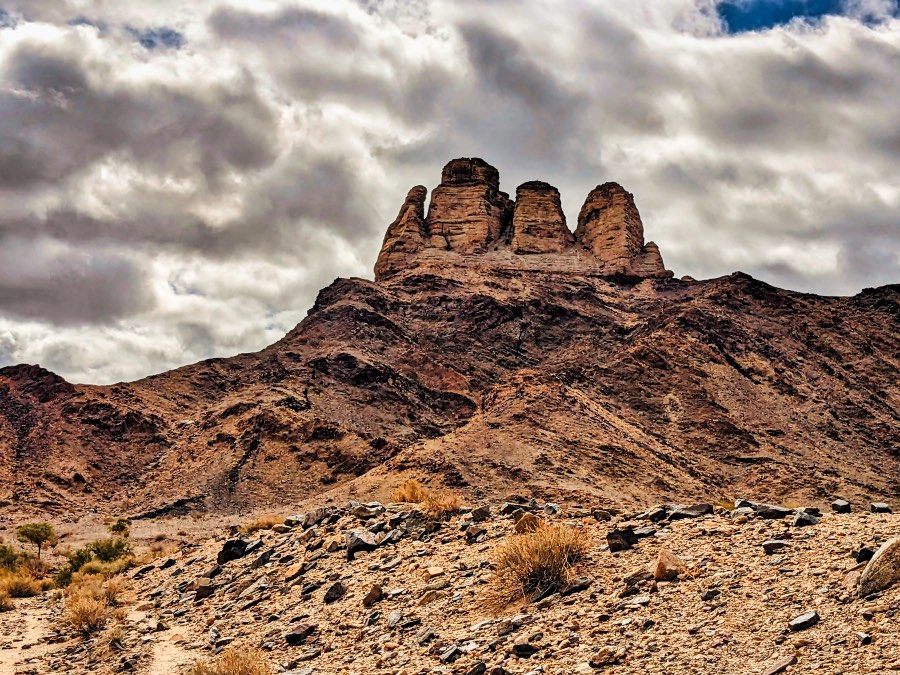
Packing List
Gear
- Good quality hiking backpack (men’s and women’s)
- Tent
- Sleeping pad
- Blow up pillow
- Sleeping bag
- Waterproof compression bag (for the sleeping bag)
- Stuff sack (for keeping clothes in while hiking)
- Headlamp
- Ground blanket
- Personal locator beacon (PLB)
Women’s Clothing
- Hiking boots
- Hiking pants
- Hiking tank top
- Long sleeve hiking shirt
- Merino underwear
- Sports bra
- Lightweight merino socks (I’m a fan of wearing two pairs when hiking)
- Fleece
- Thermal top
- Thermal leggings
- Down jacket
- Waterproof sandals
- Sunglasses
- Hat
- Buff
Men’s Clothing
- Hiking boots
- Hiking pants/shorts
- Sports t-shirt
- Merino underwear
- Lightweight Merino socks (also a fan of the double socks)
- Fleece
- Thermal top
- Thermal bottoms
- Down jacket
- Gloves
- Beanie / Toque
- Waterproof sandals
- Sunglasses
- Buff
- Hat (full-brimmed)
Cooking
- Camp stove
- Cooking set (pot, bowls and mugs)
- 1 x 230 grams fuel canister
- Collapsible tea kettle (a luxury, but it’s worth it!)
- MSR MugMate Coffee Filter
- Spork
- Pocket knife
- Lighter and matches (in a waterproof bag)
- Water bladder
- Water bottle
Sanitation
- Steripen Ultra Rechargeable Portable UV
- Hand sanitiser
- Toilet paper
- The Deuce Backpacking Potty Trowel
- Hydralites / Electrolytes (if you can’t find, salt and powdered juice packets work a treat)
- Biodegradable dish soap
- Mini sponge (just cut a regular one)
- Rubbish bags
- Dettol spray or bug spray
Personal
- Eye mask
- Ear plugs
- Toothbrush
- Biodegradable toothpaste
- Deodorant paste (decanted into a small container)
- Blister first aid kit
- First aid kit
- Sunscreen
- Lip balm with SPF
- Book / kindle
- Games to play at camp – deck of cards, or our favourite, Yahtzee
Electronics
- Phone and charging cables
- Power bank and/or solar panel
- Camera and/or GoPro plus charging cords
Where to stay before or after the Fish River Canyon hike
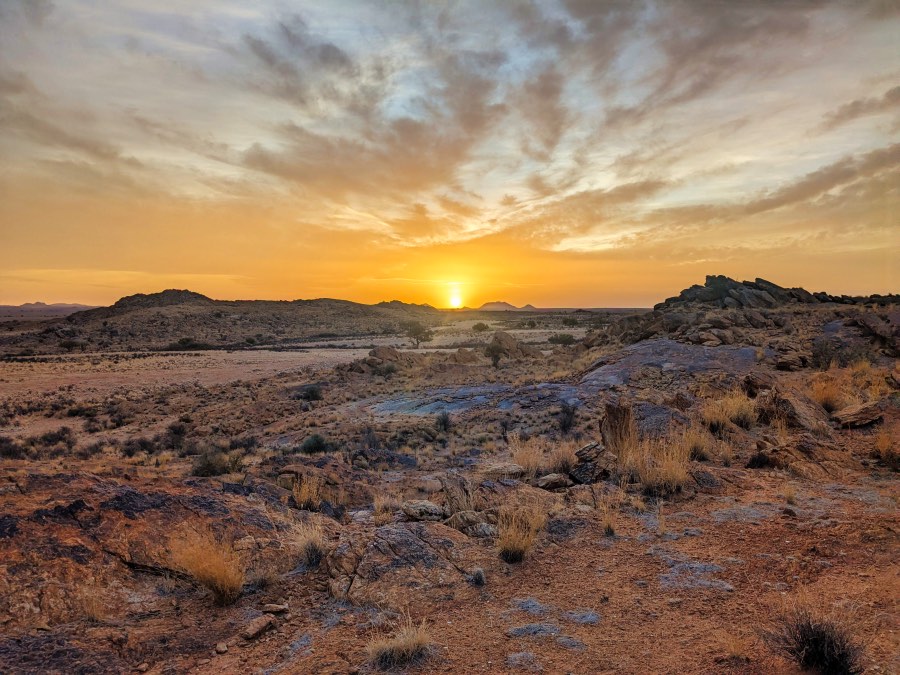
Before the Fish River Canyon Hike
Pretty much everyone stays in the national park the night before the Fish River Canyon hike. You have two options here: Ai-Ais or Hobas.
The most popular option, and the most convenient, is to leave your car at Ai-Ais, spend the night before the hike there and take the shuttle to Hobas in the morning.
While we certainly agree that it’s by far the best option to have your car at the end waiting for you, we’ll be honest, we were pretty disappointed with Ai-Ais. (And we are definitely not alone here).
It has a bit of a run-down feeling to it, as though it’s been neglected for many years. The sites aren’t maintained and the bathrooms require a good clean. This would be fine if the price tag wasn’t so hefty (320 NAD per person per night for foreigners!). It’s worth noting that SADC residents do get a discounted rate (450 NAD per site up to 4 people and 85 NAD per additional person), so if there’s someone in your group that qualifies for this rate, have them book!
While Ai-Ais is technically a hot spring resort, the only free option is the outdoor pool, which is lukewarm at best. The indoor hot springs (which are actually hot), cost 20 NAD to use.
We preferred the feel of the Hobas campsite. It has a calmer, more tranquil vibe going on. We think it’s a better place to spend the night, but that consideration needs to be weighed against the convenience of not having your car at the end.
After the Fish River Canyon Hike
So long as you can finish the Fish River Canyon hike early enough, we recommend staying elsewhere after. You’ll find better value and more beautiful campgrounds just a couple of hours north or south, depending on which direction you’re heading in.
With both options we’ve provided, you’ll have time for a soak in the hot springs and a shower, and still enough time for a cruisy drive to your camp for the night.
Heading North
The White House outside Grunau is a great place to camp if you’re headed north after the Fish River Canyon hike. It’s only 1.5 – 2 hours away from Ai-Ais and is lovely.
There are beautifully maintained pitches, clean bathrooms, friendly management and you’re provided with welcome rusks when you arrive! If you’re done with camping by this stage, they have cottages. It’s heaven.
Heading South
If you’re heading south after the Fish River Canyon hike, we love Amanzi River Camp. It’s right on the Orange River and has the most peaceful, serene feeling.
It’s only 1.5 hours away, so again, you’ll have time for the above obligatory soak and shower.
Disclaimer: This post contains affiliate links. This means that if you buy or book anything through them, we’ll earn a small commission at no extra cost to you. This helps us run this website and create comprehensive guides to help you get off the beaten track. We only recommend products and/or services that we use ourselves and trust.

